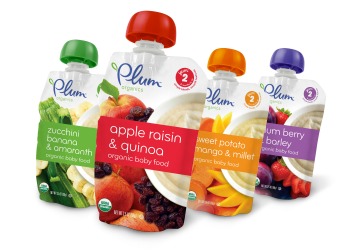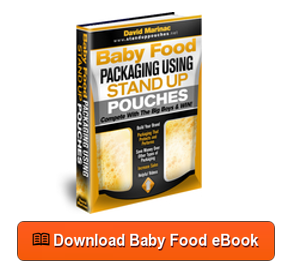Over the years we have been asked what types of baby food packaging are there to which we reply, “Many…some are good and some not as good.” We understand that anything as important as our babies and thus their baby food, the baby food packaging must be very protective, just like a parent would be for their child. Baby food packaging needs to protect, promote, and lead to purchase. We call these the 3 Ps.

First, your baby food packaging must protect the contents inside. Whether the baby food is dry or liquid or even a semi-liquid, the packaging must keep the contents fresher for longer and protect from moisture and vapor and any other negative element such as odor or even UV rays. Different types of packaging range from boxes and folding cartons to barrier bags for baby food and glass jars with lids.
Secondly, your baby food packaging must promote your product and tell the world why it is so great, long lasting and good for your baby or anything else you deem is important.
Finally, your packaging must lead to a purchase. Whether you choose a barrier bag for baby food or some other type of retail packaging, that packaging must act as your representative and encourage a consumer to pick up and ultimately buy your product.
Boxes and Folding Cartons
Boxes and folding cartons would only work for dry baby food unless there is additional packaging to contain it. This additional packaging could be barrier bags for baby food made from multiple layers of laminated film (which we’ll discuss later) or just a simple inner liner to keep the box and baby food from touching each other. Regardless, boxes and folding cartons by themselves provide very little barrier protection.
For a box or folding carton to promote the baby food it must be printed. Printing directly onto this type of packaging doesn’t produce bold and vibrant colors, as the paper just doesn’t have the gloss or shine that other materials would. In order to achieve this gloss and this type of affect the boxes need an additional coating or sealant layer to protect the ink from being scratched which adds not only to the cost but to the minimum run quantity a packaging manufacturer will require.
Printing a box or folding carton effectively will require 25,000 or more of a minimum run, depending on the size and the number of colors being printed plus printing plates and cutting dies.
Boxes and folding cartons are not as environmentally friendly as many people would imagine. First, once the paper is coated in any way with ink and a sealant layer, special attention must be taken when disposing of this packaging. Some inks and sealant layers are biodegradable however many are not.
Glass Jars and Lids
Glass jars historically have been used for baby food packaging. The glass itself is certainly protective and will keep the contents fresh until consumed. This type of packaging is great for smaller sizes or single serve quantity but isn’t the most convenient for larger multiple servings.
Glass jars will require an applied printed layer which will add to the cost. The label itself and then the application of the label to the glass jar add to the cost of this type of packaging. Glass jars, depending on the size, have a minimum run of 25,000 pieces or more.
Will a glass jar and lid lead to a purchase of your baby food? Glass jars have been used for so long and have been so universally accepted; they certainly will not hurt your chances of retail success. However, consumers are becoming aware that glass jars require a considerable amount of energy to make, space to store in a warehouse or even the amount of fuel it costs to ship them, as they are by far the heaviest packaging option of baby food packaging available.
Barrier Bags for Baby Food
Barrier bags for baby food continue to lead the way as far as innovative designs and functionality that protect, promote and lead to purchase on a store shelf. Let me explain further.
Barrier bags for baby food are made from multiple layers of laminated barrier film, this film is made specifically to lock in freshness and protect from moisture, vapor, odor, and even puncture. Further, this type of packaging can be printed up to 12 colors and requires only a 5000 piece minimum run, far less than any other type of baby food packaging.
Types of Barrier Bags for Baby Food
- Stand Up Pouches
- 3 Side Seal Flat Bags
- Spouted Stand Up Pouches
The stand up pouch continues to be a popular choice for baby food. The wide face and back and the bottom gusset area provide generous amounts of printable space to promote your product and build your brand. This style of barrier bag can work for single serve and multiple serving sizes, meaning they are available in small and very large sizes.
The 3 side seal flat barrier bags for baby food are perfect for single servings. The same laminated film will protect the contents and can be printed up to 12 colors for brand building and promoting your product.
The most popular type of baby food packaging on the market today are the spouted stand up pouches. Here a spout and cap are inserted and sealed to a stand up pouch or even a 3 side seal flat bag. Most products that use a spouted stand up pouch are wet or semi liquid as the spout and cap allow for easy pouring or a baby can suck the product right from the pouch.
Again, this type of packaging not only protects but because the minimum run quantity is only 5000 pieces for custom printing it will promote and ultimately lead to purchase of the baby food.
In closing, this has been a general overview of the types of baby food packaging being used today and some of the advantages and disadvantages of each. As always trust your packaging professional for guidance and direction as to the right one for your particular application.






